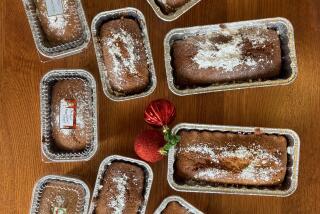An overnight sensation
STAND in line at any cappuccino bar and your eyes are drawn to the pastry case, where pieces of streusel-topped “coffeecake” wink back at you temptingly. Don’t waste the calories. Coffeecake -- real coffeecake -- is not just a cold, sweet hunk of generic cinnamon-topped cake gobbled down in the front seat of your car.
Real coffeecake is a Sunday-morning experience. It begins (if you’re a lucky houseguest) with the unforgettable aroma of bread filling the house on a winter’s morning, a yeasty smell so tantalizing that it seduces you out from the cozy bedcovers and down to the kitchen. There you pour yourself a fragrant cup of hot, strong coffee and score that slice of warm, fresh, not-too-sweet “cake” (but it’s more like a buttery sweet bread), made rich with a filling that incorporates just a few luxurious details: hazelnuts, maybe, or citrus peel or chopped bittersweet chocolate. Each bite stands up to the java.
Real coffeecake is also the all-American answer to tea time. It’s the warming, not-too-heavy snack to go with that 4 p.m. espresso.
Too much trouble? Not -- for people who like to bake -- with this update of an old family recipe that breaks the process down so that you make the dough one day and the filling the next.
It allows for slow overnight rising, which gives the coffeecake its satisfying, rich flavor, and is so versatile that one master recipe allows for an endless number of variations. Get this technique down and you’ll never need another coffeecake recipe again.
Prepare the dough using an electric mixer (there’s no kneading). Refrigerate it overnight in a covered, lightly buttered bowl. The next day, remove the dough from the refrigerator and let it stand for about half an hour to warm before rolling. You will find the dough to be pliable and easy to roll out so there’s no need for a longer standing time.
While the dough is standing, mix the meringue filling. Our master recipe calls for a hazelnut meringue, but you can vary it by adjusting the flavorings that are folded into the meringue filling. Each variation gets a different, complementary glaze. For an orange coffeecake, you’ll fold orange zest and almonds into the filling; for chocolate, you’ll use chopped semi-sweet or bittersweet chocolate with the hazelnuts. The pecan variation substitutes toasted pecans for the hazelnuts in the filling.
Next, roll out the dough and spread it with filling, then roll it up like a jelly roll. Slashing the dough reveals the meringue, creating a contrast between the filling and the pastry. There’s also a practical advantage, because it helps the coffeecake bake more evenly.
After a leisurely 45-minute rise, brush it with a little beaten egg and milk. Then, after baking, glaze it, which adds not just sweetness but complexity. For the master recipe, a rum glaze is fabulous with toasted hazelnuts that go on top to finish it.
Citrus flavor comes to the fore in an orange version of the coffeecake, with a zest-enhanced filling, juice-powered glaze and bits of candied orange peel on top. For the chocolate variation, the master glaze recipe is used with a topping of hazelnuts and chopped chocolate.
Praline is the idea for the pecan coffeecake. Its brown butter and maple syrup glaze weaves together the buttery pastry and the toasty nut flavors. Or you can simply stick with the master recipe, topping it with Brazil nuts or even chopped glace fruits such as cherries, pineapple or chestnuts.
Whichever variation you choose, our recipe makes two generous coffeecakes, so why not hide away a piece for later? Then when you get that mocha to go, you’ll have something real to enjoy with it.
*
Overnight coffeecake
Total time: 1 hour, 15 minutes plus overnight rising time, plus 1 hour, 15 minutes same-day
rising time
Servings: 20 (8 to 10 per coffeecake)
1 cup milk, divided
2 ( 1/4 ounce each) envelopes dry yeast
1/2 cup warm water (100 to 110 degrees)
4 cups flour
1 1/4 cups sugar, divided
1 teaspoon salt
2 sticks butter, cut up
3 egg yolks, lightly beaten, plus 1 egg yolk, divided
3 egg whites
2 teaspoons plus 1 tablespoon cinnamon, divided
1 1/2 cups chopped toasted hazelnuts, divided
1cup powdered sugar, sifted
1 teaspoon dark rum
(optional)
1/4 teaspoon vanilla
1. In a small saucepan, heat three-fourths cup milk to scalding. Remove from the heat and let cool to warm.
2. Sprinkle the yeast over the warm water and stir until the yeast is completely dissolved.
3. In the large bowl of an electric mixer, combine the flour, one-fourth cup sugar and the salt. Work the butter in by hand or with a pastry cutter until the mixture resembles cornmeal.
4. Combine 3 lightly beaten egg yolks, the warm milk and the yeast mixture. Add to the flour mixture and beat at medium speed until completely blended and a soft dough forms, about one minute.
5. Divide the dough into two parts and shape each into a ball. Put each into a lightly buttered bowl. Cover and refrigerate overnight.
6. Remove the dough from the refrigerator; let it stand 30 minutes. Heat the oven to 350 degrees.
7. While the dough is standing, beat the egg whites until light and foamy. Gradually beat in the remaining 1 cup sugar until stiff peaks form. Beat in 2 teaspoons of the cinnamon. Fold in 1 cup of the chopped toasted hazelnuts.
8. Take one of the dough balls, shape it into an oval and, on a lightly floured board, roll it out to form a 10- by 18-inch rectangle.
9. Spread half of the meringue mixture onto the rolled-out dough, leaving a 1-inch border. Roll up the dough lengthwise jellyroll style. Pinch the ends of the roll to seal.
10. Gently lift the roll onto a greased large baking sheet, seam side down, and form it into a horseshoe shape. Cut slashes halfway through dough at 2-inch intervals.
11. Repeat the process with the remaining half of the dough.
12. Invert a large bowl over each of the coffeecakes. Set aside to rise about 45 minutes or until doubled.
13. Lightly beat 1 egg yolk and 2 tablespoons milk. Brush each of the coffeecakes with egg wash, brushing the entire surface of the dough, but do not brush the meringue filling that shows.
14. Bake 30 to 35 minutes, until golden brown, turning the baking sheet halfway through. Cool on the pan for about 5 minutes before glazing.
15. For the glaze, stir together the powdered sugar, the remaining 2 tablespoons milk, the rum, if using, and the vanilla. Drizzle it over the coffeecakes. Sprinkle the cakes with the remaining one-half cup of chopped nuts.
Each of 20 servings: 332 calories; 6 grams protein; 45 grams carbohydrates; 2 grams fiber; 17 grams fat; 7 grams saturated fat; 62 mg. cholesterol; 134 mg. sodium.
Variations
Orange: Follow the master recipe, stirring 2 teaspoons grated orange peel into the filling. Replace 1 cup of the hazelnuts with toasted slivered almonds. For the glaze, substitute 2 tablespoons orange juice for the milk and stir in 1 teaspoon grated orange peel. After glazing, warm the coffeecakes and sprinkle 1 to 2 tablespoons chopped candied orange peel over the top of each. Omit the nuts on top.
Pecan: Follow the master recipe, replacing hazelnuts with toasted pecans in the filling. For the glaze, heat one-fourth cup butter over low heat until nut-brown, about 5 to 6 minutes. Remove from heat and let cool. Combine three-fourths cup powdered sugar, one-fourth cup firmly packed light brown sugar, the browned butter, 2 tablespoons milk, 2 tablespoons maple syrup and one-fourth teaspoon vanilla. Drizzle the glaze over warm coffeecakes, warming it in the microwave if necessary to maintain drizzling consistency. Sprinkle with one-fourth cup toasted pecan pieces.
Chocolate: Follow the master recipe, stirring one-fourth cup chopped semisweet or bittersweet chocolate into the filling along with chopped hazelnuts. Omit cinnamon. Sprinkle chopped hazelnuts and one-fourth cup chopped chocolate over the warm glazed coffeecakes.


